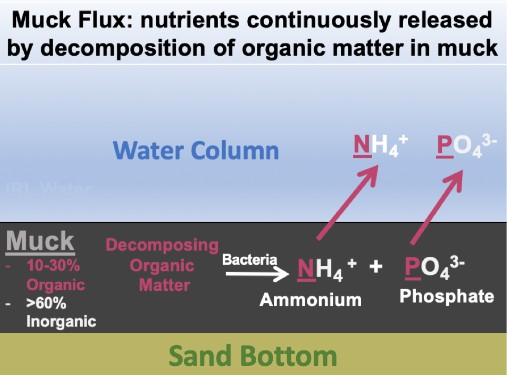(Sept 30, 2019 Lagoon Straight Talk Brief, BIRLC) Field studies in Turkey Creek (Palm Bay) in 2017 and at Lake Toho, near Kissimmee, in 2004 both show that removal of muck is associated with reductions in nutrients (nitrogen and phosphorus) entering the water. These nutrients are major causes of the poor condition of the Indian River Lagoon.
 The logic behind this is clear. The “muck flux” (how much nutrient is released into the water by muck) is a function of the area of the muck times the rate of release of nutrients by the muck. Removing all the muck down to the sand bottom creates areas that have little muck available to release nutrients, so the nutrient flux from these cleaned areas drops significantly and allows sea grasses to take root and grow. These studies also reported an increase in plant and animal populations after the muck’s removal.
The logic behind this is clear. The “muck flux” (how much nutrient is released into the water by muck) is a function of the area of the muck times the rate of release of nutrients by the muck. Removing all the muck down to the sand bottom creates areas that have little muck available to release nutrients, so the nutrient flux from these cleaned areas drops significantly and allows sea grasses to take root and grow. These studies also reported an increase in plant and animal populations after the muck’s removal.
Removing muck is only one necessary tool for restoring the Lagoon. Reducing the inflow of material that makes up the muck is essential as well;otherwise in time the same problem will return. The muck deposits formed over a period of the past50 years by silt, utility and septic system sewage, grass clippings, storm water runoff, etc. entering the Lagoon.
Until about 1996, our waste treatment plants dumped their partially treated sewage directly into the Lagoon. This largely ended due to the federal Clean Water Act and the IRL System and Basin Act of 1990, reducing contributors to muck formation. Under the Save Our Indian River Lagoon Plan other controls are also being installed, including retention ponds, baffle boxes, and other solutions, which slow the formation of new muck.
In other words, removing muck from the Lagoon floor, combined with reducing nutrient inputs, is a sound strategy for helping to restore the Lagoon. To succeed, we must continue to use the best information to adjust our plans and be committed for the long term. That is how communities like the Chesapeake Bay and Sarasota are restoring their waters.
Lagoon Straight Talk Issue Brief (Sept. 30, 2019)
References to Field Studies:
The Turkey Creek Study (Fox & Trefry, 2018)
Lake Toho Study (Hoyer, Bachmann, et al, 2008)
Ironically, hurricanes took place in both locations very shortly after the muck removal but the studies nonetheless point out that removal is an effective tool in improving water quality and restoring water bodies.




